Kabyle people
Iqbayliyen (Kabyle) | |
|---|---|
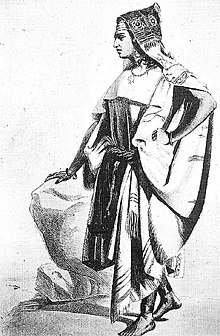 Kabyle woman | |
| Total population | |
| c. 7 million[1] | |
| Regions with significant populations | |
| Kabylie | |
| c. 5.5 million[1] | |
| c. +1 million[1] | |
| Languages | |
| Kabyle language Second languages: French, Arabic[2] | |
| Religion | |
| Predominantly Islam, with minorities of Roman Catholicism and Protestantism | |
The Kabyle people (Kabyle: Izwawen, Leqbayel or Iqbayliyen, pronounced [iqβæjlijən])[3][4] are a Berber ethnic group indigenous to Kabylia in the north of Algeria, spread across the Atlas Mountains, one hundred miles east of Algiers. They represent the largest Berber-speaking population of Algeria and the second largest in North Africa.
Many of the Kabyles have emigrated from Algeria, influenced by factors such as the Algerian Civil War,[5] cultural repression by the central Algerian government,[6] and overall industrial decline. Their diaspora has resulted in Kabyle people living in numerous countries. Large populations of Kabyle people settled in France and, to a lesser extent, Canada (mainly Québec) and United States.
The Kabyle people speak Kabyle, a Berber language. Since the Berber Spring of 1980, they have been at the forefront of the fight for the official recognition of Berber languages in Algeria.
History
During successive rule of the Romans, Byzantines, Vandals, Carthaginians and Ottomans the Kabyle people were among the few peoples in North Africa who maintained their independence.[7][8][9][10] The Kabyle people resisted very fiercely, to the extent that even after the Arab conquest of North Africa they still had possession over their mountains.[11][12] In fact throughout all of the invasions prior to the French the Kabyles had seemingly managed to maintain their independence and it was only until 1857 that they were entirely conquered.[13][14][15][16][17][18][19][20]
List of Empires/Dynasties created by the Kabyle people
- Zirid Dynasty
- Hammadid Dynasty
- Fatimid Caliphate[21][22]
- Taifa of Alpuente
- Taifa of Granada
- Kingdom of Ait Abbas
- Kingdom of Kuku
Fatimid Caliphate
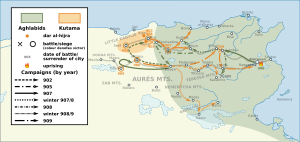
Between 902 and 909 the Fatimid state had been founded by the Kutama Berbers from Little Kabylie whose conquest of Ifriqiya resulted in the creation of the Caliphate.[23][24][25][26][27][28][29] After the conquest of Ifriqiya the Kutama Berbers conquered the realm of the Rustamids on the way to Sijilmasa which they also then briefly conquered and where Abdullāh al-Mahdī Billa, who at the time was imprisoned, was then freed and then accepted as the Imam of the movement and installed as the Caliph, becoming the first Caliph and the founder of the ruling dynasty.[30][31][32] The historian Heinz Halm describes the early Fatimid state as being "a hegemony of the Kutama and Sanhaja Berbers over the eastern and central Maghrib" and Prof. Dr. Loimeier states that rebellions against the Fatimids were also expressed through protest and opposition to Kutama rule.[33][34] The weakening of the Abbasids allowed Fatimid-Kutama power to quickly expand and in 959 Ziri ibn Manad, Jawhar the Sicilian and a Kutama army conquered Fez and Sijilmasa in Morocco.[35] [34] In 969 under the command of Jawhar, the Fatimid Kutama troops conquered Egypt from the Ikhsidids, the Kutama Berber general Ja'far ibn Fallah was instrumental in this success: he led the troops that crossed the river Nile and according to al-Maqrizi, captured the boats used to do this from a fleet sent by Ikhshidid loyalists from Lower Egypt.[36] The Kutama general Ja’far then invaded Palestine and conquered Ramla, the capital, he then conquered Damascus and made himself the master of the city and then he moved north and conquered Tripoli.[37][38] It was around this time period that the Fatimid Caliphate reached its territorial peak of 4,100,000 km2.[39]

Zirid Dynasty
The Zirid Dynasty was a family of Sanhadja Berbers with origins in the Kabyle mountains.[40] During their reign they established their rule over the entire Maghreb and also established rule in parts of Andalusia. They also had suzerainty over the Emirate of Sicily through the Kalbite emirs and later assassinated the ruler and took over the island.[41] When the Emirate of Sicily was split into separate taifas, Ayyub Ibn Tamim entered Sicily and united all of the taifas under his rule until he left the island.

Hammadid Dynasty
The Hammadids came to power after declaring their independence from the Zirids. They managed to conquer land in all of the Maghreb region, capturing and possessing significant territories such as: Algiers, Bougie, Tripoli, Sfax, Susa, Fez, Ouargla and Sijilmasa.[42][43][44] South of Tunisia, they also possessed a number of oases that were the termini of trans-Saharan trade routes.[45]
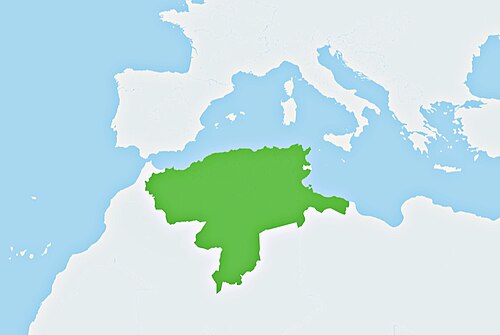
Kingdom of Ait Abbas and Kingdom of Kuku
These two Kabyle Kingdoms managed to maintain their independence and participated in notable battles alongside the Regency of Algiers, such as the campaign of Tlemcen and the conquest of Fez. In the early 16th century Sultan Abdelaziz of the Beni Abbes managed to defeat the Ottomans several times, notably in the First Battle of Kalaa of the Beni Abbes.
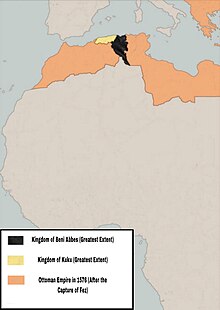

The Kabyle were relatively independent of outside control during the period of Ottoman Empire rule in North Africa. They lived primarily in three different kingdoms: the Kingdom of Kuku, the Kingdom of Ait Abbas, and the principality of Aït Jubar.[46] The area was gradually taken over by the French during their colonization beginning in 1857, despite vigorous resistance. Such leaders as Lalla Fatma n Soumer continued the resistance as late as Mokrani's rebellion in 1871.
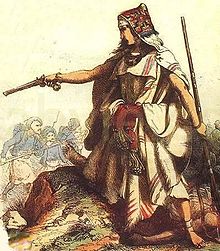
French officials confiscated much land from the more recalcitrant tribes and granted it to colonists, who became known as pieds-noirs During this period, the French carried out many arrests and deported resisters, mainly to New Caledonia in the South Pacific. Due to French colonization, many Kabyle emigrated to other areas inside and outside Algeria.[47] Over time, immigrant workers also began to go to France.
In the 1920s, Algerian immigrant workers in France organized the first party promoting Algerians independence. Messali Hadj, , , and Belkacem Radjef rapidly built a strong following throughout France and Algeria in the 1930s. They developed militants who became vital to the fighting for an independent Algeria. This became widespread after World War II.
Since Algeria gained independence in 1962, tensions have arisen between Kabylie and the central government on several occasions. In July 1962, the FLN (National Liberation Front) was split rather than united. Indeed, many actors who contributed to independence wanted a share of power but the ALN (National Liberation Army) directed by Houari Boumédiène, joined by Ahmed Ben Bella, had the upper hand because of their military forces.[citation needed]
In 1963 the FFS party of Hocine Aït Ahmed contested the authority of the FLN, which had promoted itself as the only party in the nation. Aït Ahmed and others considered the central government led by Ben Bella authoritarian, and on September 3, 1963, the FFS (Socialist Forces front) was created by Hocine Aït Ahmed.[48] This party grouped opponents of the regime then in place, and a few days after its proclamation, Ben Bella sent the army into Kabylie to repress the insurrection. Colonel Mohand Oulhadj also took part in the FFS and in the Maquis (fr) because he considered that the mujahideen were not treated as they should be.[49] In the beginning, the FFS wanted to negotiate with the government but since no agreement was reached, the maquis took up arms and swore not to give them up as long as democratic principles and justice were[clarification needed] a part of the system. But after Mohand Oulhadj's defection, Aït Ahmed could barely sustain the movement and after the FLN congress on April 16, 1964, which reinforced the government's legitimacy, he was arrested in October 1964. As a consequence, the insurrection was a failure in 1965 because it was hugely repressed by the forces of the ALN, under Houari Boumédiène. In 1965 Aït Ahmed was sentenced to death, but later pardoned by Ben Bella. Approximately 400 deaths were counted amongst the maquis.[48]
In 1980, protesters mounted several months of demonstrations in Kabylie demanding the recognition of Berber as an official language; this period has been called the Berber Spring. In 1994–1995, the Kabyle conducted a school boycott, termed the "strike of the school bag". In June and July 1998, they protested, in events that turned violent, after the assassination of singer Lounès Matoub and passage of a law requiring use of the Arabic language in all fields.
In the months following April 2001 (called the Black Spring), major riots among the Kabyle took place following the killing of Masinissa Guermah, a young Kabyle, by gendarmes. At the same time, organized activism produced the Arouch, and neo-traditional local councils. The protests gradually decreased after the Kabyle won some concessions from President Abdelaziz Bouteflika.
On 6 January 2016, Tamazight was officially recognized in Algeria's constitution as a language equal to Arabic.[50]
Geography

The geography of the Kabyle region played an important role in the people's history. The difficult mountainous landscape of the Tizi Ouzou and Bejaia provinces served as a refuge, to which most of the Kabyle people retreated when under pressure or occupation. They were able to preserve their cultural heritage in such isolation from other cultural influences.
The area supported local dynasties (Numidia, Fatimids in the Kutama periods, Zirids, Hammadids, and Hafsids of Bejaïa) or Algerian modern nationalism, and the war of independence. The region was repeatedly occupied by various conquerors. Romans and Byzantines controlled the main road and valley during the period of antiquity and avoided the mountains (Mont ferratus).[51] During the spread of Islam, Arabs controlled plains but not all the countryside (they were called el aadua: enemy by the Kabyle).[52]
The Regency of Algiers, under Ottoman influence, tried to have indirect influence over the people ( tribes of Amraoua, and marabout).[53]
The French gradually and totally conquered the region and set up a direct administration.


Algerian provinces with significant Kabyle-speaking populations include Tizi Ouzou, Béjaïa and Bouira, where they are a majority, as well as Boumerdes, Setif, Bordj Bou Arreridj, and Jijel. Algiers also has a significant Kabyle population, where they make up more than half of the capital's population.
The Kabyle region is referred to as Al Qabayel ("tribes") by the Arabic-speaking population and as Kabylie in French. Its indigenous inhabitants call it Tamurt Idurar ("Land of Mountains") or Tamurt n Iqbayliyen/Tamurt n Iqbayliyen ("Land of the Kabyle"). It is part of the Atlas Mountains and is located at the edge of the Mediterranean.
Culture and society
Language
The Kabyle ethnic group speak Kabyle, a Berber language of the Afro-Asiatic family. As second and third languages, many people speak Algerian Arabic, French and, to a lesser degree, English.
During the first centuries of their history, Kabyles used the Tifinagh writing system. Since the beginning of the 19th century, and under French influence, Kabyle intellectuals began to use the Latin script. It is the basis for the modern Berber Latin alphabet.
After the independence of Algeria, some Kabyle activists tried to revive the Old Tifinagh alphabet. This new version of Tifinagh has been called Neo-Tifinagh, but its use remains limited to logos. Kabyle literature has continued to be written in the Latin script.
Religion
The Kabyle people are mainly Muslim, with a small Christian minority.[54] Many Zawaya exist all over the region; the Rahmaniyya is the most prolific.
Catholics of Kabyle background generally live in France. Recently, the Protestant community has had significant growth, particularly among Evangelical denominations.[55]
Economy
The traditional economy of the area is based on arboriculture (orchards and olive trees) and on the craft industry (tapestry or pottery). Mountain and hill farming is gradually giving way to local industry (textile and agro-alimentary). In the middle of the 20th century, with the influence and funding by the Kabyle diaspora, many industries were developed in this region. It has become the second most important industrial region in the country after Algiers.[citation needed]
Politics

The Kabyle have been fierce activists in promoting the cause of Berber (Amazigh) identity. The movement has three groups: those Kabyle who identify as part of a larger Berber nation (Berberists); those who identify as part of the Algerian nation (known as "Algerianists", some view Algeria as an essentially Berber nation); and those who consider the Kabyle to be a distinct nation separate from (but akin to) other Berber peoples (known as Kabylists).
- Two political parties dominate in Kabylie and have their principal support base there: the Socialist Forces Front (FFS), led by Ali Laskri who replaced Hocine Aït Ahmed,[56] and the Rally for Culture and Democracy (RCD), led by Mohcine Belabbès who replaced Saïd Sadi.[57] Both parties are secularist, Berberist and Algerianist.
- The Arouch emerged during the Black Spring of 2001 as a revival of the village assembly, a traditional Kabyle form of democratic organization. The Arouch share roughly the same political views as the FFS and the RCD.
- The MAK (Movement for the Autonomy of Kabylie) also emerged during the Black Spring, It claimed the right for a regional autonomy of Kabylie. On 21 April 2010, MAK proclaimed a Provisional Government of Kabylie in exile (ANAVAD). Ferhat Mehenni was elected president by the National Council of the MAK.[58] In 2013, MAK officially became an independantist movement and changed its name to .
Diaspora
For historical and economic reasons, many Kabyles have emigrated to France, both for work and to escape political persecution. They now number around 1 million people.[59][60] Some notable French people are of full or partial Kabyle descent.
Notable people
Sports
- Mohamed Allek
- Karim Benzema
- Soraya Haddad
- Rabah Madjer
- Kylian Mbappé
- Mahieddine Meftah
- Moussa Saïb
- Samir Aït Saïd
- Zinedine Zidane
Business
Entertainment
- Abane Ramdane
- Belaïd Abrika
- Hocine Aït Ahmed
- Lucius Alfenus Senecio
- Fadela Amara
- Krim Belkacem
- Mohand Arav Bessaoud
- Ali Boumendjel
- Lalla Fatma n Soumer
- Amirouche Aït Hamouda
- Ferhat Mehenni
- Sheikh Mokrani
- Belkacem Radjef
- Saïd Sadi
- Buluggin ibn Ziri
Sciences
Writers
See also
Notes and references
- ^ Jump up to: a b c "Kabyles around the world". Retrieved July 15, 2012.
- ^ Frawley, William J. (2003). International Encyclopedia of Linguistics: AAVE - Esperanto, Volume 1. Oxford University Press. p. 221. ISBN 978-0195139778. Retrieved 21 December 2017.
- ^ "Centre de Recherche Berbère - Ecriture: Libyque & tifinagh". www.centrederechercheberbere.fr. Retrieved 2021-04-18.
- ^ Lanfry, Jacques (1978). "Les Zwawa (Igawawen) d'Algérie centrale (essai onomastique et ethnographique)". Revue des mondes musulmans et de la Méditerranée. 26 (1): 75–101. doi:10.3406/remmm.1978.1825.
- ^ "The Kabyle Berbers, AQIM and the search for peace in Algeria | Algeria | al Jazeera".
- ^ http://www.dtic.mil/dtic/tr/fulltext/u2/a585705.pdf
- ^ The Middle East and North Africa: Pg 156
- ^ Sketches of Algeria During the Kabyle War By Hugh Mulleneux Walmsley: Pg 118
- ^ The Kabyle People By Glora M. Wysner
- ^ The Encyclopedia Americana, Volume 1: Pg 568
- ^ The art journal London, Volume 4: Pg 45
- ^ The Barbary Coast By Henry Martyn Field: Pg 93
- ^ Scottish Geographical Magazine, Volume 10; Volume 1894
- ^ The Twentieth Century, Volume 71
- ^ Walks in Algiers and Its Surrounding
- ^ The United Service Magazine
- ^ The art journal London, Volume 4
- ^ Winter and Spring on the Shores of the Mediterranean: Or The Genoese Rivieras, Italy, Spain (etc.) - Fifth Ed - James Henry Bennet, . Churchill
- ^ The Kabyle People - By Glora M. Wysner
- ^ The History of Colonization from the Earliest Times to the Present Day, Volume 1 - Henry Crittenden Morris - Macmillan
- ^ African Foreign Policy and Diplomacy from Antiquity to the 21st Century, Volume 1: Pg 92
- ^ An Atlas of African History by J. D. Fage: Pg 11
- ^ Governance and Pluralism under the Fatimids (909-996 CE) - Dr. Shainool Jiwa
- ^ The Shi'i World: Pathways in Tradition and Modernity
- ^ Nanjira, Daniel Don (2010). African Foreign Policy and Diplomacy from Antiquity to the 21st Century. ABC-CLIO. p. 92. ISBN 978-0-313-37982-6.
- ^ Fage, J. D. (1958). An Atlas of African History. E. Arnold. p. 11.
- ^ International Journal of Economic and Social History, Volume 8
- ^ Chroniques des années algériennes
- ^ Fatimid’s legal system
- ^ Gall, Timothy L.; Hobby, Jeneen (2009). Worldmark Encyclopedia of Cultures and Daily Life: Africa. Gale. p. 329. ISBN 978-1-4144-4883-1.
- ^ Studies, American University (Washington, D. C. ) Foreign Area (1979). Algeria, a Country Study. [Department of Defense], Department of the Army. p. 15.
- ^ Orientalia, Volumes 54-55
- ^ Halm, Heinz (2014). "Fāṭimids". In Fleet, Kate; Krämer, Gudrun; Matringe, Denis; Nawas, John; Rowson, Everett (eds.). Encyclopaedia of Islam, THREE. Brill Online. ISSN 1873-9830.
- ^ Jump up to: a b Muslim Societies in Africa: A Historical Anthropology - Roman Loimeier Indiana University Press,
- ^ Heinz Halm (1996). Der Nahe und Mittlere Osten. BRILL. p. 399. ISBN 90-04-10056-3.
- ^ Lev, Yaacov (1979). "The Fāṭimid Conquest of Egypt — Military Political and Social Aspects". Israel Oriental Studies. 9: 315–328. ISSN 0334-4401.
- ^ First Crusader: Byzantium's Holy Wars
- ^ The Asiatic Journal and Monthly Register for British India and Its Dependencies, Volume 24 Black, Parbury, & Allen,
- ^ Turchin, Peter; Adams, Jonathan M.; Hall, Thomas D (December 2006). "East-West Orientation of Historical Empires". Journal of World-Systems Research. 12 (2): 222. ISSN 1076-156X
- ^ A History of Africa - J.D. Fage: Pg 166
- ^ The Cambridge History of Africa, Volume 3 - J.D. Fage: Pg 16
- ^ Saladin, the Almohads and the Banū Ghāniya: The Contest for North Africa: Pg 42
- ^ Islam: Art and Architecture: Pg 614
- ^ Historical Dictionary of the Berbers (Imazighen): Pg 55 & 56
- ^ Nomads and Crusaders, A.D. 1000-1368 By Archibald Ross Lewis
- ^ E. J. Brill's First Encyclopaedia of Islam, 1913-1936, Volume 4, publié par M. Th. Houtsma, Page: 600
- ^ Bélaïd Abane, L'Algérie en guerre: Abane Ramdane et les fusils de la rébellion, p. 74
- ^ Jump up to: a b Monbeig, Pierre (1992). "Une opposition politique dans l'impasse. Le FFS de Hocine Aït-Ahmed". Revue du monde musulman et de la Méditerranée. 65 (1): 125–140. doi:10.3406/remmm.1992.1560. ISSN 0997-1327.
- ^ Said Malik Cheurfa ⵣ (2011-08-03), Révolte de Hocine Ait Ahmed et Mohand Oulhadj en 28 septembre 1963 par Malik Cheurfa.flv, retrieved 2019-04-22
- ^ "AVANT PROJET DE REVISION DE LA CONSTITUTION" (PDF). Algeria Press Service. 6 January 2016. Retrieved 28 May 2019.
- ^ "Ebook LA KABYLIE ORIENTALE DANS L'HISTOIRE - Pays des Kutuma et guerre coloniale de Hosni Kitouni". www.harmatheque.com. Retrieved 2016-11-29.
- ^ Abdelfettah Lalmi, Nedjma (2004-01-01). "Du mythe de l'isolat kabyle". Cahiers d'Études Africaines (in French). 44 (175): 507–531. doi:10.4000/etudesafricaines.4710. ISSN 0008-0055.
- ^ Universalis, Encyclopædia. "KABYLES". Encyclopædia Universalis. Retrieved 2016-11-29.
- ^ Abdelmadjid Hannoum, Violent Modernity: France in Algeria, Page 124, 2010, Harvard Center for Middle Eastern studies, Cambridge, Massachusetts.Amar Boulifa, Le Djurdjura à travers l'histoire depuis l'Antiquité jusqu'en 1830 : organisation et indépendance des Zouaoua (Grande Kabylie), Page 197, 1925, Algiers.
- ^ Lucien Oulahbib, Le monde arabe existe-t-il ?, page 12, 2005, Editions de Paris, Paris.
- ^ https://www.euronews.com/2012/05/12/election-hit-by-irregularities-says-algerian-opposition-leader, Euronews, "Election hit by irregularities, says Algerian opposition leader", www.euronews.com, 12 May 2012, accessed 5 October 2020
- ^ https://www.algeriepatriotique.com/2020/09/29/mohcine-belabbes-si-le-tribunal-me-convoque-je-repondrai-present/, Mounir Serraï, "Mohcine Belabbès : «Si le tribunal me convoque, je répondrai présent»", www.algeriepatriotique.com, 29 September 2020, accessed 5 October 2020
- ^ www. kabylia-gov.org, Kabylia Government website
- ^ Salem Chaker, "Pour une histoire sociale du berbère en France" Archived 2012-11-12 at the Wayback Machine, Les Actes du Colloque Paris - Inalco, Octobre 2004
- ^ James Minahan, Encyclopedia of the Stateless Nations: D-K, Good Publishing Group, 2002, p.863. Quote: "Outside North Africa, the largest Kabyle community, numbering around 1 million, is in France."
External links
| Wikiquote has quotations related to: Kabyle people |
| Wikimedia Commons has media related to Kabyle people. |
| Wikisource has the text of the 1911 Encyclopædia Britannica article Kabyles. |
- Provisional Government of Kabylie (ANAVAD)
- Kabyle Movement of Autonomy[permanent dead link]
- Kabyle centric news site (in Kabyle)
- Social web site
- Kabyle centric news site (in French)
- Ethnologue.com about Kabyle language
- Algerian linguistic policy (in French)
- Cultural site (in French)
- Analysis
- Kabyle people
- Ethnic groups in Algeria
- Indigenous peoples of North Africa
- Berber peoples and tribes
